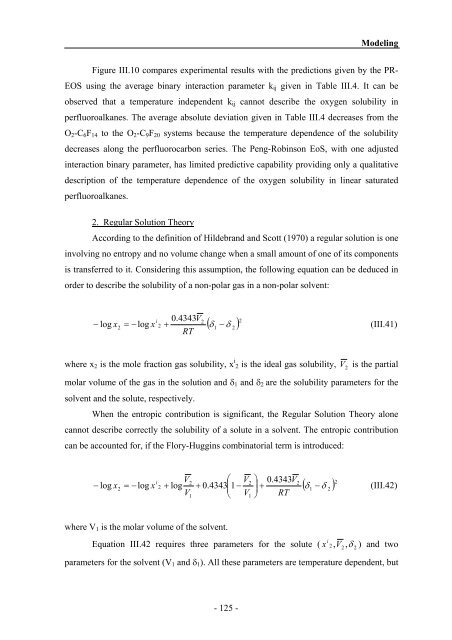n - PATh :.: Process and Product Applied Thermodynamics research ...
n - PATh :.: Process and Product Applied Thermodynamics research ...
n - PATh :.: Process and Product Applied Thermodynamics research ...
You also want an ePaper? Increase the reach of your titles
YUMPU automatically turns print PDFs into web optimized ePapers that Google loves.
Modeling<br />
Figure III.10 compares experimental results with the predictions given by the PR-<br />
EOS using the average binary interaction parameter kij given in Table III.4. It can be<br />
observed that a temperature independent kij cannot describe the oxygen solubility in<br />
perfluoroalkanes. The average absolute deviation given in Table III.4 decreases from the<br />
O2-C6F14 to the O2-C9F20 systems because the temperature dependence of the solubility<br />
decreases along the perfluorocarbon series. The Peng-Robinson EoS, with one adjusted<br />
interaction binary parameter, has limited predictive capability providing only a qualitative<br />
description of the temperature dependence of the oxygen solubility in linear saturated<br />
perfluoroalkanes.<br />
2. Regular Solution Theory<br />
According to the definition of Hildebr<strong>and</strong> <strong>and</strong> Scott (1970) a regular solution is one<br />
involving no entropy <strong>and</strong> no volume change when a small amount of one of its components<br />
is transferred to it. Considering this assumption, the following equation can be deduced in<br />
order to describe the solubility of a non-polar gas in a non-polar solvent:<br />
−<br />
x<br />
2<br />
log 2 = −log<br />
2 + δ 1 − δ 2<br />
(<br />
i 0.<br />
4343V<br />
2<br />
x<br />
) (III.41)<br />
RT<br />
where x2 is the mole fraction gas solubility, x i 2 is the ideal gas solubility, V 2 is the partial<br />
molar volume of the gas in the solution <strong>and</strong> δ1 <strong>and</strong> δ2 are the solubility parameters for the<br />
solvent <strong>and</strong> the solute, respectively.<br />
When the entropic contribution is significant, the Regular Solution Theory alone<br />
cannot describe correctly the solubility of a solute in a solvent. The entropic contribution<br />
can be accounted for, if the Flory-Huggins combinatorial term is introduced:<br />
−<br />
i V ⎛ V<br />
⎜ −<br />
⎞<br />
⎟<br />
0.<br />
4343V<br />
2 ) (III.42)<br />
⎝ ⎠<br />
2<br />
2<br />
2<br />
log x2<br />
= −log<br />
x 2 + log + 0.<br />
4343⎜1<br />
⎟ + δ 1 − δ 2<br />
V1<br />
V1<br />
RT<br />
where V1 is the molar volume of the solvent.<br />
Equation III.42 requires three parameters for the solute ( x 2 , V2<br />
, δ 2<br />
i<br />
) <strong>and</strong> two<br />
parameters for the solvent (V1 <strong>and</strong> δ1). All these parameters are temperature dependent, but<br />
- 125 -<br />
(



